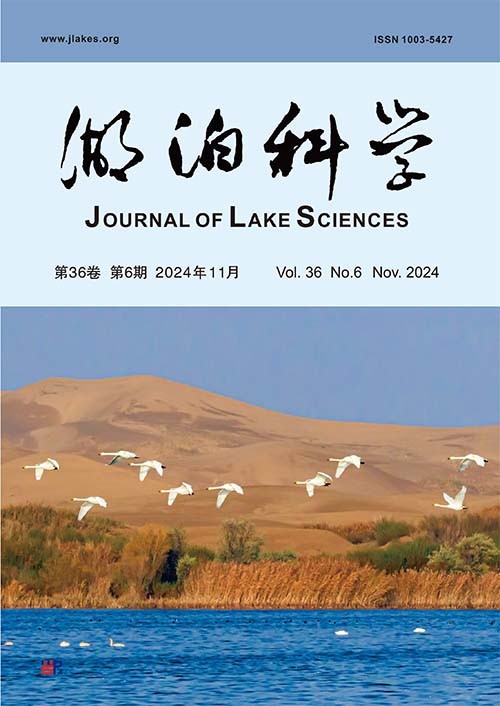A method for continuous monitoring of the ebullition process and application to methane flux variations in Xiangxi Bay, Three Gorges Reservoir
Q2 Earth and Planetary Sciences
引用次数: 1
Abstract
气泡释放是天然水体释放CH4的主要途径之一,准确量化水体气泡释放量对于辨析其“汇、源”特性至关重要。自然水体释放气泡的不连续性、不确定性使得监测其过程较为困难。本研究针对水体气泡释放监测难题,通过改进倒置漏斗型气泡通量监测装置提出了一种气泡释放过程连续监测方法。本方法测量对象为定长时间监测水域释放气泡的体积,经室内外实验验证,其理论量程为3.6~132 mL/(m2·min),测量结果能够较好的表征10~40 m水深缓流水体气泡体积通量变化特征。运用该方法于2021年6—11月对三峡水库支流香溪河库湾开展CH4气泡通量连续监测,并分析不同环境因子对其产生的影响。结果表明:监测期间,研究水域CH4气泡通量变化范围为0.02~8.13 mg/(m2·d),且各采样点间CH4气泡通量呈现较高的时空变异性;CH4气泡通量与水温、水体pH呈显著正相关关系,与水深及水体电导率呈显著负相关关系。其中,水深可能是决定水体是否通过气泡形式释放CH4的重要影响因素,水深超过38.35 m后水体可能不再通过气泡形式释放CH4。然而,这一水深阈值是否同样适用于三峡水库其它支流还需要更多实验验证。本研究对于揭示三峡水库典型支流气泡态CH4排放过程具有重要意义。;Ebullition is one of the main pathways for the release of CH4 from natural water bodies. It is important to accurately quantify the amount of ebullition in water bodies in order to distinguish between their ‘sink’ and ‘source’ characteristics. However, the discontinuity and uncertainty of ebullition in natural waters make it difficult to monitor the process. To meet the challenge of ebullition monitoring, a method for continuous monitoring of the ebullition process has been proposed by improving the inverted funnel bubble flux monitor. The measurement object of this method is the volume of bubbles released in the monitored water area during a fixed period of time. The theoretical range of this method is 3.6-132 mL/(m2·min) through indoor and outdoor experiments, and the measurement results can better characterize the variation characteristics of ebullitive flux in the slow-flowing water body with the depth of 10-40 m. This method was applied to continuously monitor methane ebullitive flux in Xiangxi Bay, Three Gorges Reservoir, and the influences of various environmental factors on methane ebullitive flux were analyzed. The results showed that during the measurement period, the variation range of methane ebullitive flux was 0.02-8.13 mg/(m2·d), and the ebullitive flux between sampling points showed high spatial-temporal variability. The ebullitive flux was positively correlated with water temperature and pH, and negatively correlated with water depth and conductivity; moreover, water depth might be an important factor in determining whether CH4 was released by ebullition: after the water depth exceeded 38.35 m, the ebullitive flux was below 0.38 mg/(m2·d). However, whether the threshold value (38.35 m) was applicable to other tributaries of the Three Gorges reservoir requires further experimental verification. This study is useful to reveal the emission process of CH4 bubbles in typical tributaries of the Three Gorges Reservoir.三峡库区香溪湾沸腾过程连续监测方法及甲烷通量变化研究
气泡释放是天然水体释放CH4的主要途径之一,准确量化水体气泡释放量对于辨析其“汇、源”特性至关重要。自然水体释放气泡的不连续性、不确定性使得监测其过程较为困难。本研究针对水体气泡释放监测难题,通过改进倒置漏斗型气泡通量监测装置提出了一种气泡释放过程连续监测方法。本方法测量对象为定长时间监测水域释放气泡的体积,经室内外实验验证,其理论量程为3.6~132 mL/(m2·min),测量结果能够较好的表征10~40 m水深缓流水体气泡体积通量变化特征。运用该方法于2021年6—11月对三峡水库支流香溪河库湾开展CH4气泡通量连续监测,并分析不同环境因子对其产生的影响。结果表明:监测期间,研究水域CH4气泡通量变化范围为0.02~8.13 mg/(m2·d),且各采样点间CH4气泡通量呈现较高的时空变异性;CH4气泡通量与水温、水体pH呈显著正相关关系,与水深及水体电导率呈显著负相关关系。其中,水深可能是决定水体是否通过气泡形式释放CH4的重要影响因素,水深超过38.35 m后水体可能不再通过气泡形式释放CH4。然而,这一水深阈值是否同样适用于三峡水库其它支流还需要更多实验验证。本研究对于揭示三峡水库典型支流气泡态CH4排放过程具有重要意义。;Ebullition is one of the main pathways for the release of CH4 from natural water bodies. It is important to accurately quantify the amount of ebullition in water bodies in order to distinguish between their ‘sink’ and ‘source’ characteristics. However, the discontinuity and uncertainty of ebullition in natural waters make it difficult to monitor the process. To meet the challenge of ebullition monitoring, a method for continuous monitoring of the ebullition process has been proposed by improving the inverted funnel bubble flux monitor. The measurement object of this method is the volume of bubbles released in the monitored water area during a fixed period of time. The theoretical range of this method is 3.6-132 mL/(m2·min) through indoor and outdoor experiments, and the measurement results can better characterize the variation characteristics of ebullitive flux in the slow-flowing water body with the depth of 10-40 m. This method was applied to continuously monitor methane ebullitive flux in Xiangxi Bay, Three Gorges Reservoir, and the influences of various environmental factors on methane ebullitive flux were analyzed. The results showed that during the measurement period, the variation range of methane ebullitive flux was 0.02-8.13 mg/(m2·d), and the ebullitive flux between sampling points showed high spatial-temporal variability. The ebullitive flux was positively correlated with water temperature and pH, and negatively correlated with water depth and conductivity; moreover, water depth might be an important factor in determining whether CH4 was released by ebullition: after the water depth exceeded 38.35 m, the ebullitive flux was below 0.38 mg/(m2·d). However, whether the threshold value (38.35 m) was applicable to other tributaries of the Three Gorges reservoir requires further experimental verification. This study is useful to reveal the emission process of CH4 bubbles in typical tributaries of the Three Gorges Reservoir.
本文章由计算机程序翻译,如有差异,请以英文原文为准。
求助全文
约1分钟内获得全文
求助全文
来源期刊

湖泊科学
Environmental Science-Water Science and Technology
CiteScore
3.70
自引率
0.00%
发文量
3253
期刊介绍:
Journal of Lake Sciences (ISSN 1003-5427) was founded in 1989 and is jointly sponsored by Nanjing Institute of Geography and Lake Sciences, Chinese Academy of Sciences and Chinese Society of Oceanology and Limnology. It mainly reports the latest research results on the changes in resources, ecology and environment of lakes (including reservoirs) and their basins under the interaction between man and nature. It publishes theoretical or applied research papers, briefs and reviews on various disciplines related to lake science (such as physics, chemistry, biology, ecology, geology, geography, etc.) as well as lake engineering and integrated basin management. Since 2006, the journal has been changed to a bimonthly publication, published on January, March, May, July, September and November 6 by Science Press.
 求助内容:
求助内容: 应助结果提醒方式:
应助结果提醒方式:


